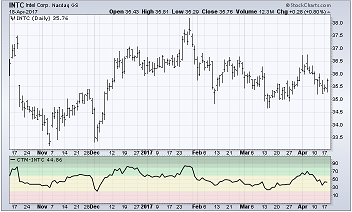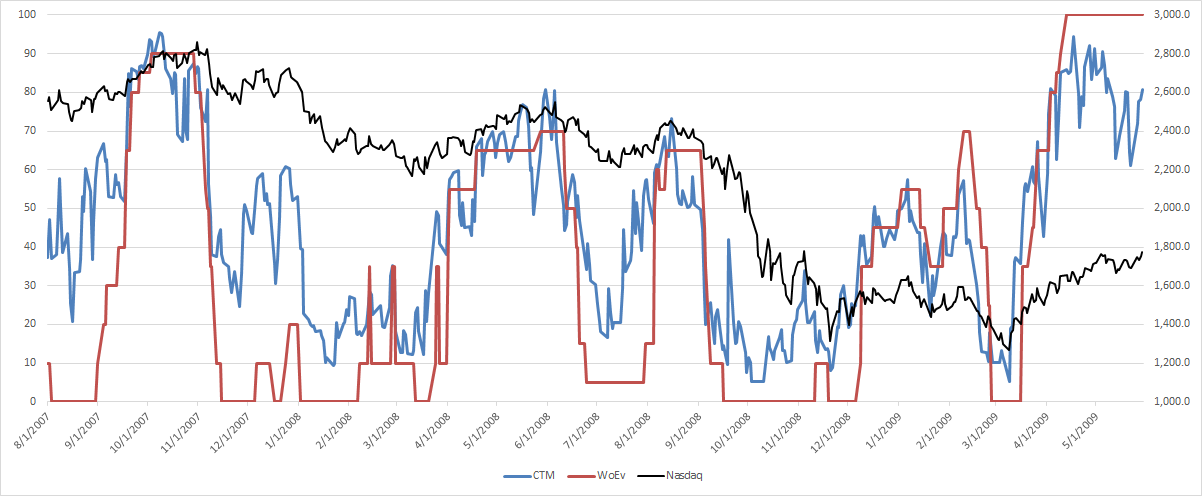 In my recent Building a Rules-Based Trend Following Model series, I talked extensively about the Weight of the Evidence. This is my measure to tell me what the market is doing based upon nine different technical measures made up of price, breadth, and relative strength (PBR, like the beer). Tushar Chande introduced a substitute for your use with his Chande Trend Meter (CTM) in a recent article. This was a wonderful happening since I cannot divulge the exact details of my Weight of the Evidence, as it is still used to manage millions of dollars. This means you have a good trend measure to use in a trend model. Chart A shows my WoEv (Weight of the Evidence) in red, and Tushar’s CTM in blue with the black line being the Nasdaq Composite. The period shown is the bear market from 10/2007 until 3/2009 with a few months added at each end. It should be obvious that CTM and WoEv have similarities in what constitutes a trend and the reversals of that trend, yet they are constructed very differently.
In my recent Building a Rules-Based Trend Following Model series, I talked extensively about the Weight of the Evidence. This is my measure to tell me what the market is doing based upon nine different technical measures made up of price, breadth, and relative strength (PBR, like the beer). Tushar Chande introduced a substitute for your use with his Chande Trend Meter (CTM) in a recent article. This was a wonderful happening since I cannot divulge the exact details of my Weight of the Evidence, as it is still used to manage millions of dollars. This means you have a good trend measure to use in a trend model. Chart A shows my WoEv (Weight of the Evidence) in red, and Tushar’s CTM in blue with the black line being the Nasdaq Composite. The period shown is the bear market from 10/2007 until 3/2009 with a few months added at each end. It should be obvious that CTM and WoEv have similarities in what constitutes a trend and the reversals of that trend, yet they are constructed very differently.
 Chart A
Chart A
I will attempt to point out some differences in the two measures so that you can understand when using CTM, which is available on StockCharts.com, and my WoEv which was the subject of 13 articles on rules-based trend following model building.
My WoEv is based upon Nasdaq Composite data, both price and breadth. Tushar’s CTM is independent of the underlying security or index. It does its calculations on the price series being used, much like most technical indicators. The information below was taken directly from StockCharts.com’s ChartSchool article that covered CTM:
The calculation of the Chande Trend Meter is based on the following technical indicators:
The position of the high, low, and close, relative to the Bollinger bands in four different timeframes (20-day, 50-day, 75-day, and 100-day).
The price change relative to the standard deviation over the past 100 days.
The 14-day RSI value.
The existence of any short-term (2-day) price channel breakouts.
The resulting score is converted to a 0-100 scale for ease of comparison.
You can see from Chart A that my WoEv is not as volatile which means the signals are easier to define. You can also see that there are a few areas in which they are not in sync such as mid-2007 and early 2008. Recall from my article series, that an indicator used for buying and selling is not worth much unless you create a set of rules to follow. Rules that tell you when to buy, how much to buy, and what the stop loss percentages are. You can certainly accomplish that using CTM. However, because of its more volatile movement, the rules need to be broader. Tushar says that 60 – 100 is an uptrend, further broken down into 3 levels of very strong, strong, and weak. Levels of 20 – 60 are flat or weak downtrends, and 0 – 20 are strong downtrends.
The real beauty of CTM is that you can use it on any price series; stocks, mutual funds, ETFs, indices, etc. The correlation of WoEv and CTM is 0.83, which is really good, especially considering they are very different measures. You can also use CTM on weekly data which will reduce its volatility. In a future article I will attempt to offer some rules to help you use CTM in a way that I use my WoEv.
Dance with the Trend,
Greg Morris






